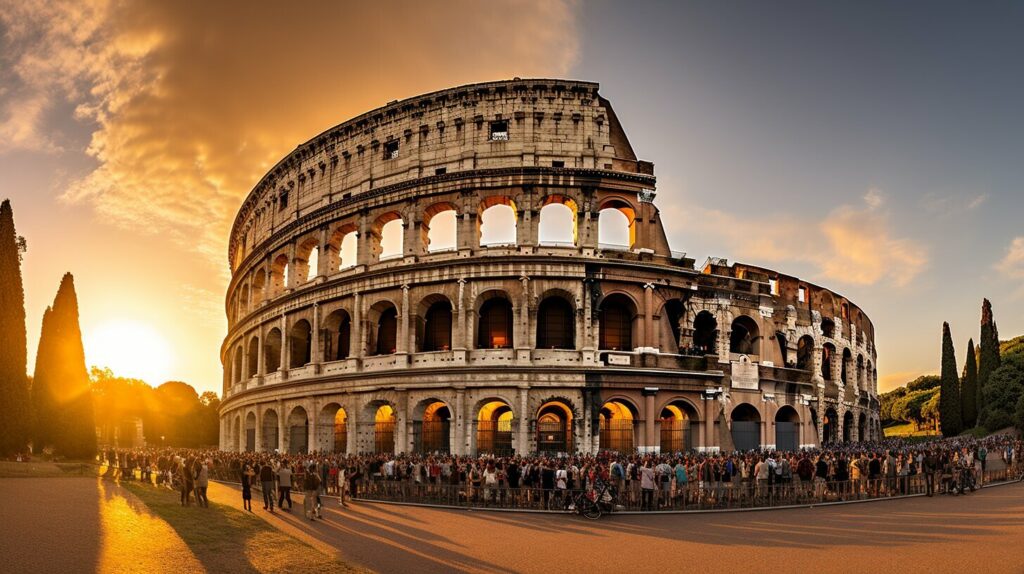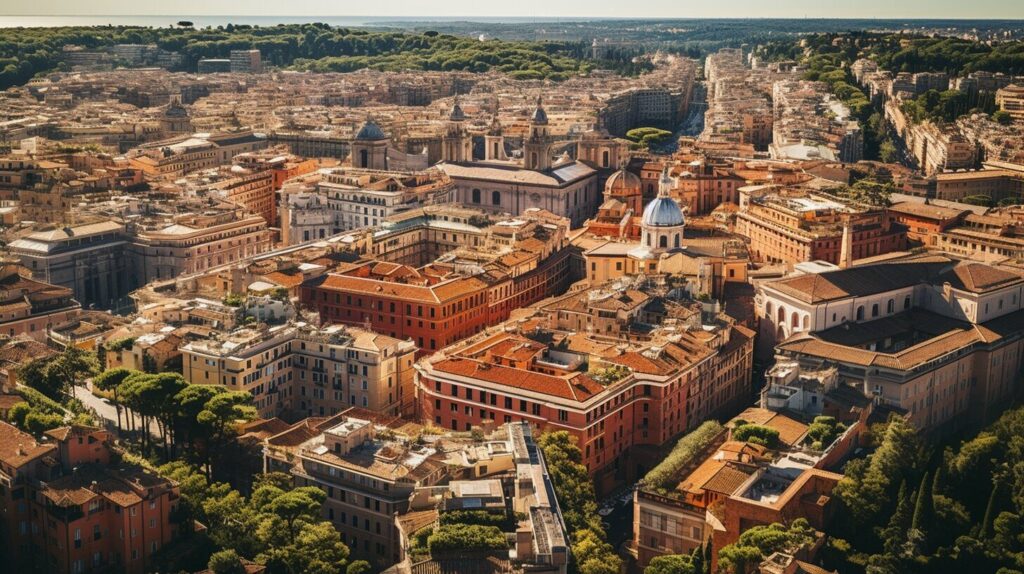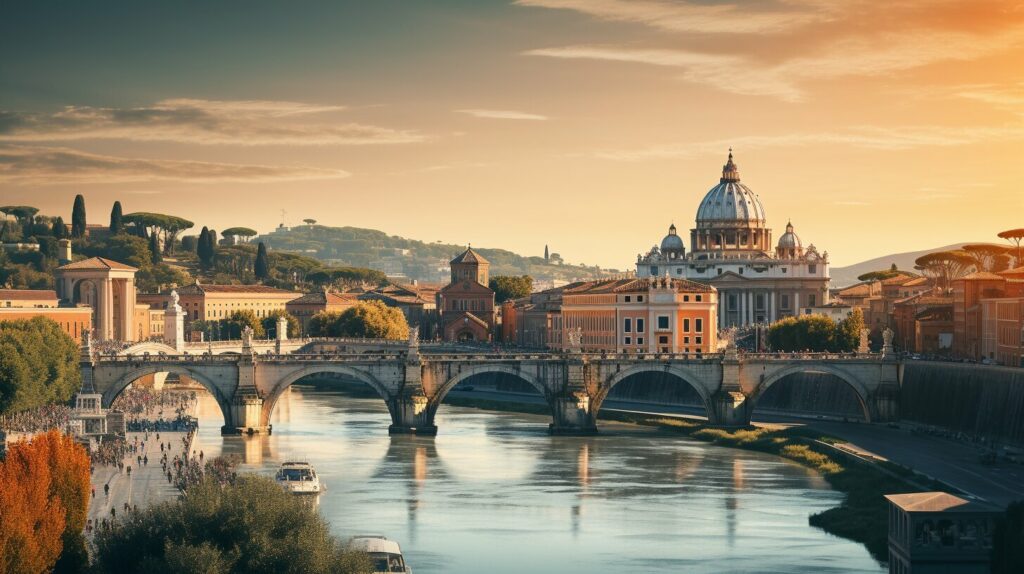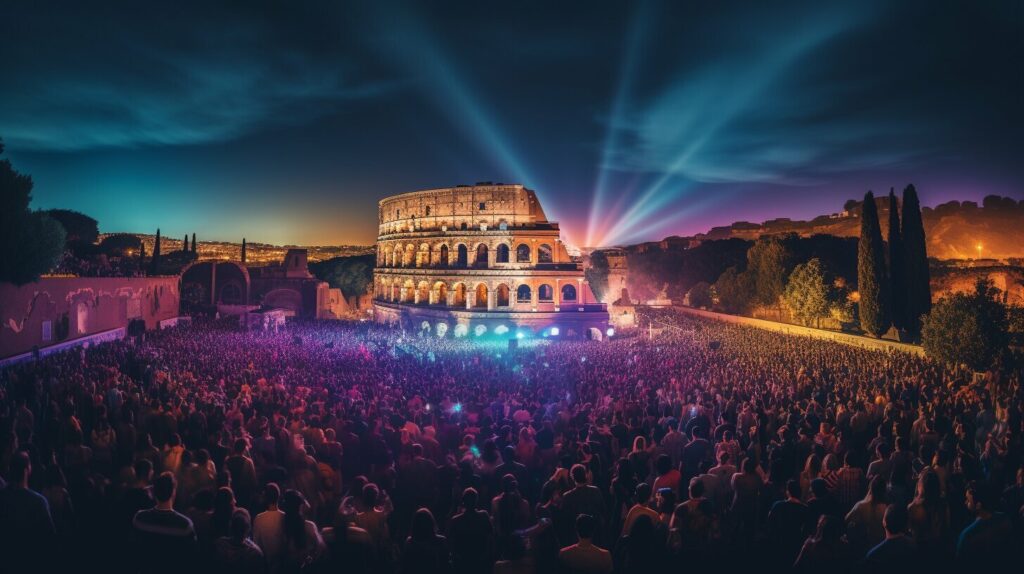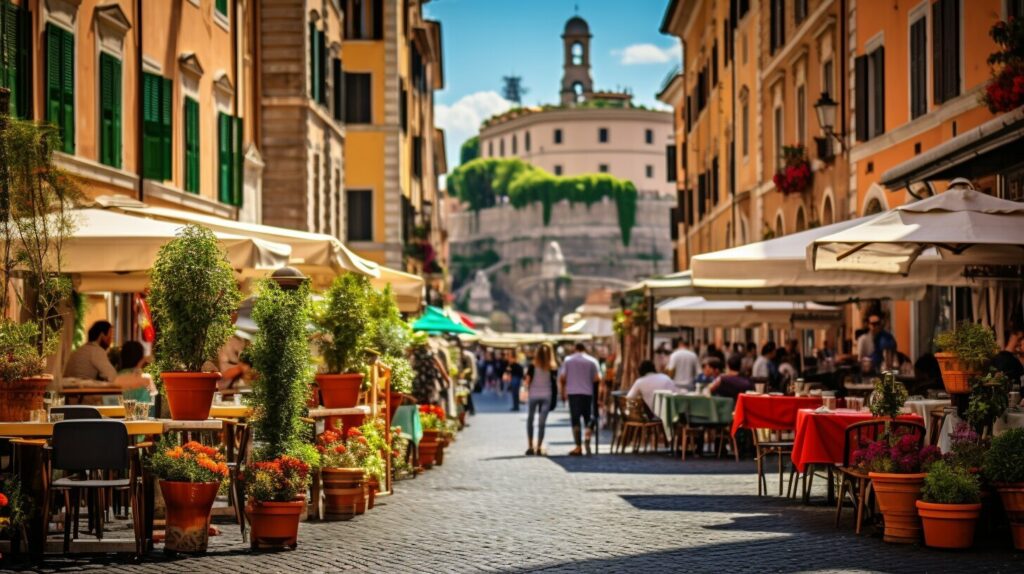When it comes to exploring Europe’s most fascinating destinations, Rome is undoubtedly on top of the list. With over two thousand years of history, this eternal city has something for everyone, from ancient ruins and museums to charming piazzas and delectable cuisine. Whether you’re a first-time visitor or a seasoned traveler, Rome will leave you awe-inspired with its timeless allure and unforgettable experiences.
So, where should you start your Roman adventure? Here’s a list of the top places to visit in Rome that should be on your itinerary.
Key Takeaways
- Discover ancient grandeur and gladiatorial history at the Colosseum
- Experience spiritual majesty and artistic beauty at Vatican City
- Walk through ancient history at the Roman Forum
- Throw a coin for good luck at the Trevi Fountain
- Be awed by the architecture and mysteries of the Pantheon
- Enjoy the Baroque beauty of Piazza Navona and its famous fountain
- Take in romantic vistas and eternal charm at the Spanish Steps and Trinità dei Monti
- Explore the subterranean city of the dead at the Roman Catacombs
The Colosseum: Ancient Grandeur and Gladiatorial History
The Colosseum is one of the most iconic monuments in Rome, standing as a testament to the glory days of the Roman Empire. Built in 80 AD, this ancient amphitheater has been the site of some of the most brutal and epic battles in history, as gladiators fought for their lives in front of cheering crowds.
The Colosseum was a marvel of engineering, designed to seat up to 80,000 spectators and equipped with elaborate systems to flood the arena for naval battles. Today, visitors to Rome can take a tour of the Colosseum, where they can explore the underground chambers where gladiators prepared for their battles and see the intricate network of tunnels that once housed exotic animals for the arena.
To truly appreciate the grandeur and history of the Colosseum, it’s recommended to book a guided tour that will take you through all the fascinating details and stories behind this iconic monument. Visitors can also purchase skip-the-line Colosseum tickets online to avoid the long queues and make the most of their time in Rome.
The Colosseum: A Must-See Attraction in Rome
Visiting the Colosseum is an unforgettable experience that will transport you back in time to the glory days of ancient Rome. From the impressive architecture to the legendary battles that took place within its walls, the Colosseum is a must-see attraction for anyone visiting Rome.
“The Colosseum stands as a testament to the glory and brutality of the Roman Empire, and visiting it is a humbling reminder of our own place in history.”
Vatican City: Spiritual Majesty and Artistic Beauty
Vatican City is a small independent city-state located within Rome that boasts an abundance of art, history, and spirituality. The heart of Vatican City is St. Peter’s Basilica, the largest Christian church in the world, and the magnificent Sistine Chapel, known for its breathtaking ceiling painted by Michelangelo. But there is much more to explore within the walls of this mini-state, including museums, gardens, and other architectural marvels.
| Attractions | Description |
|---|---|
| St. Peter’s Basilica | The largest Christian church in the world, with its impressive dome, intricate mosaics, and awe-inspiring sculptures, including Michelangelo’s Pietà. |
| The Sistine Chapel | A must-visit for art lovers, the chapel is known for its incredible ceiling painted by Michelangelo, as well as frescoes by other Italian Renaissance masters. |
| Vatican Museums | With over 70,000 works on display, including ancient Roman sculptures, Renaissance paintings, and Egyptian mummies, the museums are a treasure trove of art and history. |
Besides these iconic attractions, there are other noteworthy sites that should not be missed, such as the Vatican Gardens, a tranquil oasis in the heart of the city, and the stunning spiral staircase at the Vatican Museum. Keep in mind that the Vatican is a busy place, so it’s important to plan ahead and book tickets in advance to avoid long lines.
With its rich cultural legacy and spiritual importance, Vatican City is a must-visit destination in Rome for anyone seeking a truly unforgettable experience.
The Roman Forum: Walking Through Ancient History
If you are interested in ancient history, a visit to the Roman Forum is a must. Once the center of political and social activities in Rome, the Forum is now a sprawling archaeological site dotted with impressive ruins that provide a glimpse into the lives of the ancient Romans.
The Forum is home to several important structures that date back to different periods of Roman history. The ruins include the Temple of Saturn, the Arch of Titus, and the Curia Julia, where the Roman Senate used to meet. Visitors can also explore the Forum’s basilicas, public squares, and walk along the Sacred Way, the main road that linked the Forum to the Colosseum.
The Heart of Ancient Rome
The Roman Forum was the beating heart of ancient Rome, where the city’s citizens came to gather, trade, and socialize. Here, political debates were held, court trials were conducted, and religious ceremonies were performed. Julius Caesar’s funeral pyre was also lit in the Forum, and Augustus triumphantly returned to Rome after defeating his enemies on the battlefield.
Visiting the Forum offers a unique opportunity to step back in time and experience the glory and grandeur of ancient Rome firsthand. From the towering columns of the Temple of Castor and Pollux to the remains of the Rostra, where famous orators addressed the crowds, the Forum is a fascinating outdoor museum that provides a glimpse into the past.
“In its prime, the Roman Forum was the most celebrated meeting place in the world, and in all history.”
Discovering the Roman Forum
Visitors to the Forum can explore the ruins on their own or join a guided tour for a more in-depth understanding of the site’s history and importance. Tickets can be purchased on-site or online, and a combined ticket with the Colosseum and Palatine Hill is also available.
Be sure to wear comfortable shoes, as the ground can be uneven and rocky in some areas. Water and sunscreen are also recommended, especially during the summer months, as there is little shade in the Forum.
A visit to the Roman Forum is a must for anyone interested in history, archaeology, or the ancient world. Walking through the ruins, it’s easy to imagine the vibrant city that once bustled with life and activity. It’s an experience you won’t soon forget.
Trevi Fountain: A Coin Toss for Good Luck
As one of Rome’s most iconic attractions, the Trevi Fountain is a must-visit for anyone exploring the city. The magnificent Baroque fountain, known in Italian as Fontana di Trevi, is located in the Trevi district of Rome and has been a popular tourist destination for centuries.
The Trevi Fountain stands at over 85 feet tall and is adorned with intricate carvings and statues portraying various mythological figures. The most prominent sculpture is that of Neptune, the Roman god of the sea, riding a chariot pulled by horses and sea creatures.
But the real charm of the Trevi Fountain lies in the tradition of throwing a coin into the fountain for good luck. According to legend, if you toss a coin over your shoulder into the fountain with your right hand, you are guaranteed to return to Rome one day. Throwing a second coin will ensure a new romance, while a third coin will lead to marriage.
It’s no surprise that the Trevi Fountain is one of the most photographed landmarks in all of Rome. Whether you’re here to admire the stunning architecture, make a wish, or simply people-watch, a visit to the Trevi Fountain is an unforgettable Roman experience.
The Pantheon: Awe-Inspiring Architecture and Ancient Mysteries
The Pantheon is one of the most remarkable architectural structures in Rome, and a testament to the engineering ingenuity of the ancient Romans. Built in AD 118-128, it continues to inspire awe in visitors today.
The Pantheon’s most distinctive feature is its massive dome, which spans 142 feet and remains the world’s largest unreinforced concrete dome. The oculus, or central opening, at the top of the dome allows natural light to enter the building, creating stunning patterns of light and shadow that change throughout the day.
“The Pantheon is the most architecturally perfect building in the world.” – Le Corbusier
The Pantheon’s construction has long been shrouded in mystery, with some historians suggesting that it may have been built on the site of an ancient Etruscan temple. The building’s purpose has also been a subject of debate, with some believing that it was originally intended to be a temple to all gods, while others speculate that it may have been a mausoleum for Emperor Hadrian and his successors.
Despite its age, the Pantheon has been remarkably well-preserved, and visitors can still appreciate many of the building’s original features, including the marble floors and the stunning Corinthian columns that surround the central rotunda. The Pantheon is also home to the tombs of several famous figures, including the artist Raphael and the first two kings of Italy.
The Pantheon Dome
The Pantheon’s dome is an engineering marvel that has fascinated architects for centuries. The dome was made using a series of progressively lighter rings of brickwork, with each ring reinforcing the one below it. This technique allowed the dome to be built to such an enormous size without collapsing under its own weight.
Perhaps even more impressive is the fact that the Pantheon’s dome was constructed without the use of any wooden formwork or scaffolding. Instead, the builders used an elaborate system of wooden centring to support the dome as it was being built.
The Pantheon and Religion
Throughout its history, the Pantheon has played an important role in the religious life of Rome. In the early years of Christianity, the building was used as a temple to all gods, but it was later consecrated as a Christian church by Pope Boniface IV in AD 609.
Today, the Pantheon is still an important religious symbol, and visitors can attend mass in the building on Sundays and holy days. The building is also a popular tourist attraction, drawing millions of visitors each year who come to appreciate its remarkable architecture and ancient history.
Piazza Navona: A Burst of Baroque Beauty
If you’re looking for a true taste of Rome’s Baroque architecture, look no further than Piazza Navona. This lively square is home to three magnificent fountains, including Bernini’s famous Fountain of the Four Rivers, and the stunning Sant’Agnese in Agone church.
Take a stroll through the square and admire the surrounding buildings adorned with elegant balconies and intricate details. Don’t forget to snap a photo with the Fountain of the Four Rivers, which features sculptures depicting the major rivers of the world.
If you visit during the holiday season, you’ll be treated to a magical Christmas market, complete with artisan crafts and festive lights. And for those seeking a romantic atmosphere, the square’s charming cafes and restaurants offer the perfect spot to enjoy a leisurely meal or drink with your loved one.
Spanish Steps and Trinità dei Monti: Romantic Vistas and Eternal Charm
If you’re looking for a romantic escape in Rome, the Spanish Steps and Trinintà dei Monti are the perfect destinations. These iconic landmarks offer stunning vistas of the city, while exuding a romantic ambiance that is felt by all who visit.
Start your journey at the base of the Spanish Steps, which lead up to the church of Trinità dei Monti. As you climb the steps, take in the view of the bustling Piazza di Spagna below. Once you reach the top, you’ll be rewarded with a breathtaking panorama of Rome’s rooftops and church spires.
The church of Trinità dei Monti, situated at the top of the Spanish Steps, is a masterpiece of Renaissance architecture. Its façade boasts a symmetrical design, with two bell towers at either end, which create a harmonious balance. The interior of the church is equally stunning, showcasing impressive frescoes and ornate decorations.
After admiring the church, take a stroll along the scenic Via Condotti, home to some of Rome’s most exclusive designer boutiques. As you walk, you’ll pass by historic buildings and charming cafes, and you’ll feel the allure of this eternal city.
To cap off your romantic adventure, head back to the Spanish Steps at sunset. The tranquil atmosphere and breathtaking views will take your breath away and capture your heart.
Roman Catacombs: Exploring the Subterranean City of the Dead
If you’re looking for an alternative, off-the-beaten-path experience in Rome, the Roman Catacombs are a must-visit attraction. These underground burial sites offer a glimpse into the city’s early Christian history and provide a fascinating insight into the ancient Roman way of life.
The Catacombs of San Callisto are the largest and most well-known catacombs in Rome, with over 90 acres of underground tunnels and burial chambers. The site was used by early Christians as a place for burials and secret religious ceremonies during a time when Christianity was illegal in Rome.
| Address: | Via Appia Antica, 110/126, 00179 Roma RM, Italy |
|---|---|
| Tickets: | €8-€10 (depending on the type of tour) |
| Hours: | 9 am – 12 pm, 2 pm – 5 pm (daily except Tuesdays) |
As you explore the winding corridors of the catacombs, you’ll see various types of tombs and grave markers, including simple niches, ornate sarcophagi, and even family tombs complete with living areas and kitchens. You’ll also see beautiful frescoes and mosaics depicting early Christian symbolism and stories.
The Catacombs of San Sebastiano and San Domitilla are also worth a visit, offering their own unique insights into early Christian history and Roman burial practices.
Note that while the catacombs are fascinating, they may not be suitable for everyone. The underground tunnels can be narrow and claustrophobic, and some tours require a fair amount of walking and stair-climbing. However, for those willing to brave the depths, the Roman Catacombs offer a truly unforgettable experience.
Conclusion
In conclusion, Rome is a city that never fails to amaze. From the iconic Colosseum to the spiritual majesty of Vatican City, there are countless experiences to be had in this timeless city. Walking through the ruins of the Roman Forum, tossing a coin into the Trevi Fountain, and gazing in awe at the Pantheon’s dome are just a few of the unforgettable moments visitors can enjoy. The romantic vistas of the Spanish Steps and Trinità dei Monti, the burst of Baroque beauty at Piazza Navona, and the mysteries of the Roman Catacombs add to the allure of Rome.
Whether it’s your first or fiftieth visit, Rome will never cease to captivate and enchant. It’s a city that embraces both its ancient past and its modern present, blending them seamlessly into an experience that is truly unforgettable. So pack your bags, grab your passport, and get ready for an adventure unlike any other in one of Europe’s most magnificent cities.
FAQ
Q: What are the top places to visit in Rome?
A: The top places to visit in Rome include the Colosseum, Vatican City, the Roman Forum, Trevi Fountain, the Pantheon, Piazza Navona, the Spanish Steps and Trinità dei Monti, and the Roman Catacombs.
Q: What is the Colosseum?
A: The Colosseum is an iconic ancient amphitheater in Rome that was used for gladiatorial contests, public spectacles, and other events during the Roman Empire.
Q: What can I see in Vatican City?
A: In Vatican City, you can visit St. Peter’s Basilica, the Sistine Chapel, the Vatican Museums, and other notable attractions within this independent city-state.
Q: What is the Roman Forum?
A: The Roman Forum is an archaeological site in Rome that was once the center of political, commercial, and social activities in ancient Rome. It is a fascinating place to explore ancient ruins and learn about Roman history.
Q: What is the Trevi Fountain famous for?
A: The Trevi Fountain is famous for its stunning Baroque architecture and the tradition of throwing a coin into the fountain for good luck.
Q: What is the Pantheon?
A: The Pantheon is a remarkable ancient temple in Rome known for its awe-inspiring dome, architectural marvels, and the mysteries surrounding its construction.
Q: What can I see at Piazza Navona?
A: At Piazza Navona, you can admire the beautiful Baroque architecture, enjoy the vibrant atmosphere, and marvel at the famous Fountain of the Four Rivers by Bernini.
Q: What are the Spanish Steps and Trinità dei Monti?
A: The Spanish Steps are a set of iconic steps in Rome that lead up to the Trinità dei Monti church. From there, you can enjoy romantic vistas and panoramic views of the city.
Q: What are the Roman Catacombs?
A: The Roman Catacombs are ancient underground burial chambers in Rome that hold historical and religious significance. They offer a unique glimpse into the subterranean city of the dead.
